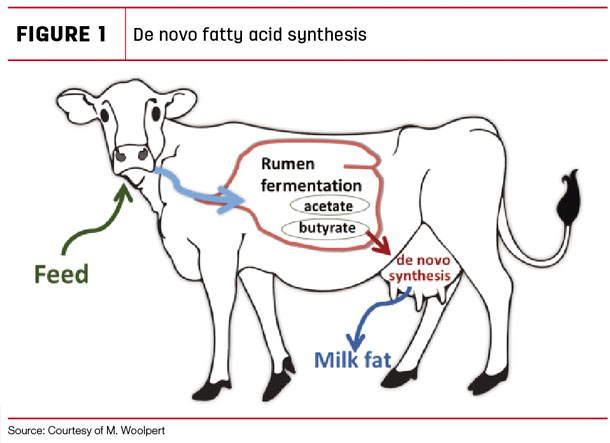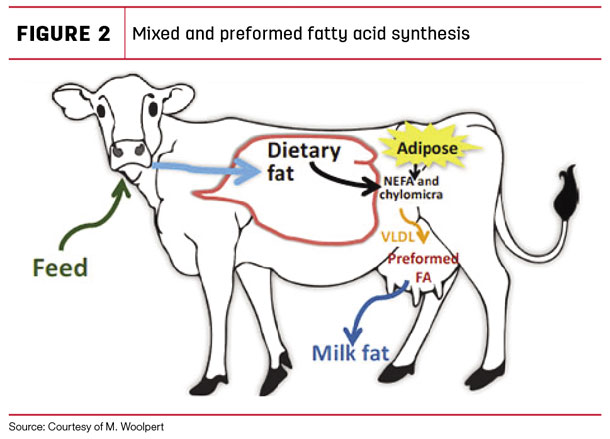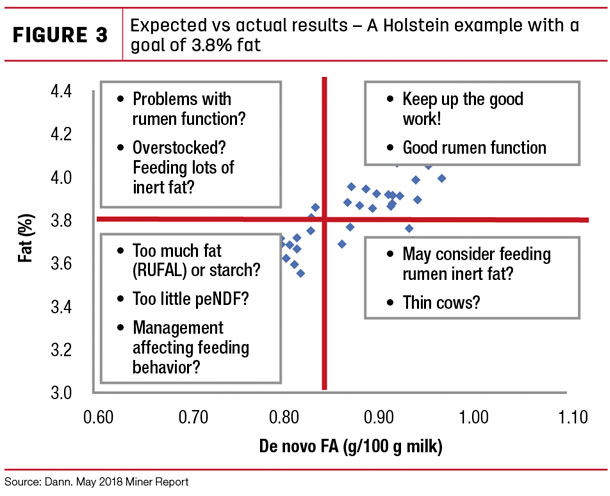One new tool producers and nutritionists may use to gain insight into component concentration and to potentially increase the value of milk is to run analysis of individual fatty acids produced by the cows on their farms.
To better understand this, we first have to look at what milkfat is composed of. Milkfat is primarily made up of triglycerides (about 98%), with the remainder composed of phospholipids, glycerol molecules, cholesterol and free fatty acids (FFAs). Triglycerides are molecules consisting of a glycerol backbone with three fatty acid tails. There have been more than 400 fatty acids identified in milkfat, with the majority of them in the form of C:4 to C:18 fatty acids.
When farms run a fatty acid analysis of their milk, they are looking for the proportions and chemical makeup of these free fatty acids. The tests are conducted by using mid-infrared (MIR) to determine the relative proportions of de novo (C4 to C14), mixed origin (C16) and preformed (C18:0 and longer) fatty acids in milk.
The MIR analysis can also provide information regarding the mean fatty acid chain length and the degree of unsaturation of the fatty acids. De novo fatty acids are those made within the mammary gland from acetate and butyrate precursors as a result of healthy rumen fermentation (Figure 1).

Mixed origin (C16) fatty acids are fats either made in the mammary gland or derived from feedstuffs in the diet. Lastly, preformed (C18) fatty acids are either derived from the diet or from mobilizing adipose tissue (Figure 2).

Results from fatty acid analysis in milk are expressed in grams per 100 grams of milk (g/100g milk). The sum of these fatty acids is roughly 94.5% of the fat test you see from your creamery report. The remaining 5% of the milkfat sample is due to the glycerol portion of fat. According to the Miner Institute, a Holstein herd with healthy rumen fermentation and low risk factors for milkfat depression (MFD) will have de novo fatty acids of 0.87 g/100 g milk, mixed-origin fatty acids of 1.41 g/100 g milk and preformed fatty acids of 1.46 g/100 g milk.
What do the results mean, and why should I care?
Now that we know the background to fatty acid analysis and how it’s measured, how do we utilize this information for the benefit of your herd? Fatty acid analysis can give us insight to a multitude of things: rumen fermentation health, the impact of total unsaturated fat content (RUFAL) of the diet, and management risk factors like overstocking, feed availability and diet dynamics. Why does this matter? According to Barbano, for every .01 g/100g milk increase in de novo fatty acids, a resulting 0.02% increase in milkfat percentage occurs. Bottom line: Higher de novo fatty-acid concentration can improve your profitability.
With target fatty acid analysis numbers for a typical Holstein herd of 0.87 g/100 g milk for de novo, 1.41 g/100 g milk for mixed origin and 1.46 g/100 g milk for preformed, differences in your farm’s results can give you clues as to what is impacting your dairy (Figure 3).

Slight breed differences in the proportion of fatty acids produced exist and will be impacted by concentration of fat in milk. (For example, Jersey cows typically produce slightly more de novo fatty acids as a percent of total fatty acids. Target de novo fatty acid g/100 g of milk will need to be adjusted for Jersey, crossbred or mixed herds.)
In general, herds with higher de novo fatty acids focus on promoting a healthier rumen environment. De novo fatty acids are highly correlated with milkfat concentration and also positively correlated with milk protein concentration. It is suggested that the correlation between de novo fatty acids and milk protein concentration is due to the higher microbial biomass that provides essential amino acids in support of milk protein synthesis.
High de novo herds tend to adhere to the following principles:
1) Lower stocking densities (less than 110%) and at least 18 inches of bunk space per cow. High stocking density and limited space leads to slug feeding, resulting in reduced rumen pH. A reduction in rumen pH can shift rumen microbial populations to those which produce bioactive fatty acids known to depress milkfat.
2) Feed availability is increased as these herds tend to feed more often (two times per day or more) and push up more often (every two to three hours). Additional feedings and pushups ensure that feed is always available, allowing cows to have a more consistent rumen environment.
3) Rations will typically contain less unsaturated fats (RUFAL) in combination with adequate levels of physically effective fiber (peNDF). Diets with low physically effective fiber reduce the ability to buffer the rumen, decreasing substrate for de novo fatty acid synthesis.
Several “watch-outs” must be considered when interpreting a herd’s de novo fatty acid numbers. It is important to remember that the milk fatty acid analysis values are expressed in grams of fatty acids per 100 grams of milk (i.e., as a proportion). Consequently, as one category (de novo, mixed or preformed) increases, the others must decrease. This becomes especially relevant in the context of feeding rumen inert fat, such as palmitic acid; the proportion of preformed fatty acid will likely increase in the milk, resulting in a decrease in the de novo fatty acid g/100 g milk.
However, it has been consistently shown that feeding palmitic acid increases milkfat yield. Despite a decrease in the proportion of de novo fatty acids in milk, overall yield of de novo fatty acids increases in this scenario. It is important to interpret milk fatty acid test results with these considerations in mind. While benchmarks like in Figure 3 are a helpful starting point, work with your nutritionist to determine your own internal benchmarks specific to your herd.
What to do with the information and how often should you collect it?
Milk fatty acid analysis can be used for a multitude of reasons, but the two primary reasons for its use are:
- troubleshoot diet and environment management problems by using analysis as a “herd snapshot.” Fatty acid analysis can provide a producer or nutritional consultant more specific information about diet and environmental factors that cause milkfat depression rather than milkfat and protein percentage alone.
- To establish a baseline over time, which can help to identify problems from seasonal changes, forage changes or herd dynamics. This allows the producer to anticipate diet and/or management changes due to seasonality or facility dynamics.
To date, fatty acid analysis tests can be costly and may not be economical for use as a routine test. As the technology develops, one might see an increase in availability from labs across the country and will even see incorporation into processor lab analysis. Until the analysis becomes economically feasible for every producer, there are a few things to work on to improve de novo fatty acid synthesis and thus increase your milkfat and protein percentages:
- Feed properly formulated diets:
o Provide high-quality forages while balancing carbohydrate supply and fermentation pools.
o Focus on adequate particle size, fewer fines and more effective fiber sources.
o Feed saturated fatty acids while controlling intake of unsaturated fatty acids (RUFAL).
- Manage cows to optimize rumen fermentation and cow comfort:
o Ensure cow comfort by providing adequate lying and bunk space and minimize overstocking pens.
o Ensure feed is consistently mixed and delivered at the same time and place every day.
o Increase cow feeding frequency by increasing the number of times fed per day and the number of times feed is pushed up (small, more frequent meals).
o Minimize heat stress and other stressors that can affect feeding behavior.
Conclusion
The value of milk solids heavily influences the price dairymen receive for their milk. Increasing milkfat yield, particularly from de novo fatty acid synthesis, can have a significant impact on the bottom line. Testing milk for proportions of de novo and preformed fatty acids can provide insight to dairy owners, nutritionists or veterinarians on how rumen function is going on a particular dairy at a given time.
Understanding what fatty acids are in the milk you are producing can help you make nutritional and management decisions, especially during times of change, such as heat stress, herd dynamics or feeding of new forages. If testing isn’t economical for your dairy, adhering to some of the principles used by herds that are at the top of de novo fatty acid production can help you do the same. ![]()
References omitted but available upon request. Click here to email an editor.
Josh Peters is a professional animal scientist and nutritionist based in Moses Lake, Washington. Chad Jenkins is a nutritionist based in Omaha, Nebraska. The authors provide nutritional and management consulting services as part of Standard Nutrition Company. The company blends custom dairy mineral and vitamin supplements with facilities in Iowa, Washington, Idaho and Texas.

-
Mike Brady
- Nutritionist
- Standard Nutrition Company
- Email Mike Brady






